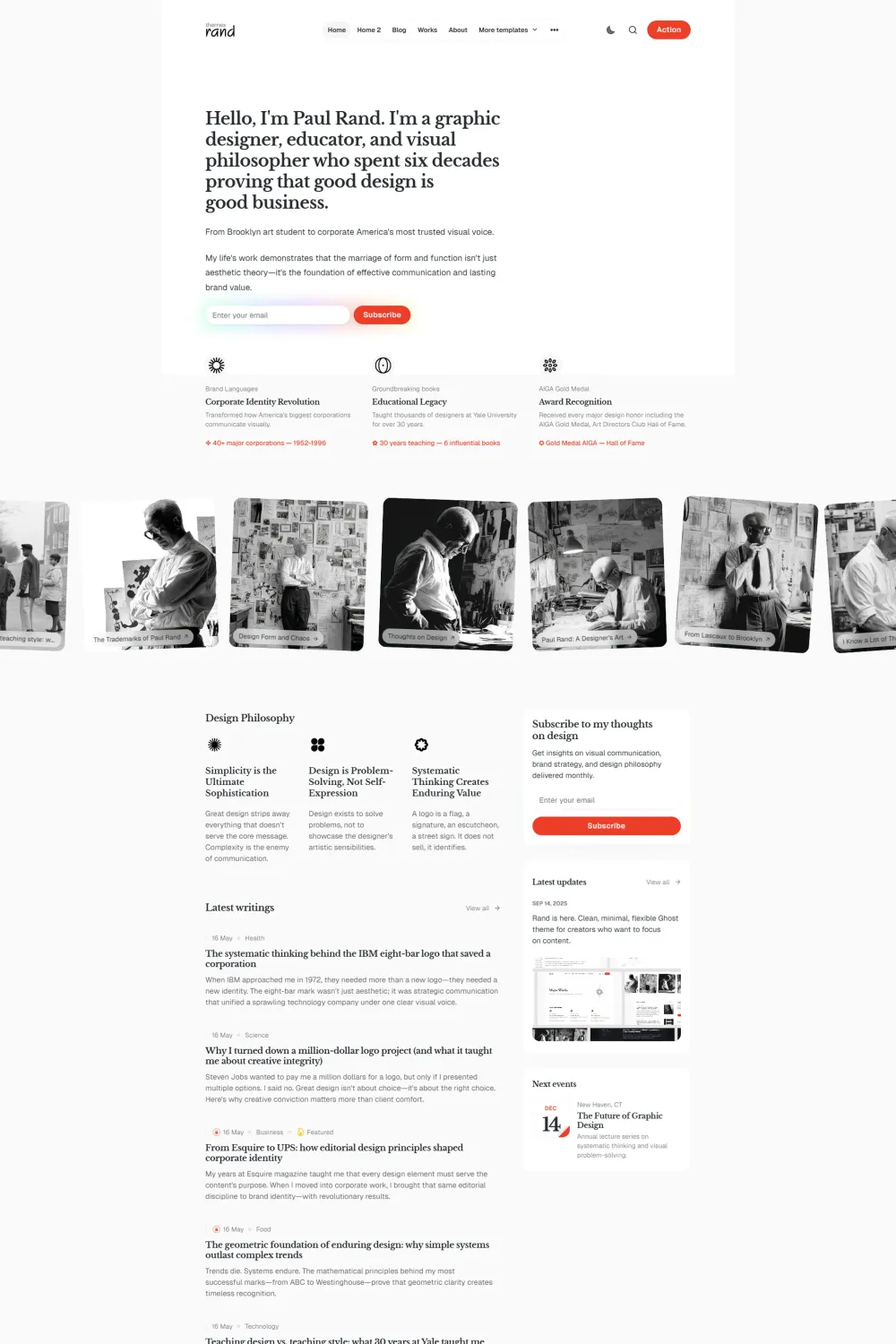Is your Ghost blog ready for 2025? If you want a clean, magazine-meets-portfolio look that you can assemble from reusable sections—without touching code—Rand nails it. It’s built for Ghost 6.x, ships with documented setup (including demo content import), and costs $89. I recommend it for personal blogs, portfolios, and creator hubs where writing and projects live side-by-side.
Key Takeaways
- Minimal personal/magazine hybrid with 15 homepage sections and 10 page templates.
- Clean typography, light/dark modes, named color presets, and TOC-friendly post layouts.
- Ghost 6.x–ready with clear docs, routes.yaml, demo content, and internal tags import.
- Pros: clean layout; rich set of dedicated pages (portfolio, collections, now, timelines).
- Cons: weak accessibility (35% with ~30 issues reported); overlaps with other Themex personal themes.
What makes Rand unique?
A flexible, section-based system that turns Ghost’s native tags and pages into a no-code builder—so I can mix blog, collections, timelines, “Now,” events, and landing pages on one cohesive personal site.
Theme overview
Rand positions itself as “minimalist magazine meets personal portfolio,” and that’s exactly how it feels in the demo: a tidy two-column layout that gives posts space while keeping timely bits (newsletter box, events, “Now”) accessible. The product page confirms Ghost 6.x compatibility and the $89 license, while the documentation walks through install, routes, demo import, and internal tags. Themex’s brand also carries social proof (“Trusted by 500+ writers”).
Top features of the Rand Ghost theme
- Section-first homepage with a long list of reusable blocks (gallery, highlights, showcases, logos, “Now,” events, blocks, and more).
- Landing Page template that reuses the same sections to build focused pages (e.g., resources or case studies).
- Collections/Resource template for listing items (great for “Works”/portfolio or curated links).
- Blog template with horizontal tag navigation and multiple post layouts with TOC support.
- Link-in-bio (Linktree-like) template to centralize links.
- Series & Timeline templates for linear reading and chronological milestones.
- Event calendar section to list upcoming items via Pages (with documented setup).
- Light/Dark/System/User modes plus color presets; typography options via Ghost admin.
- One-click/demo content import to mirror the demo, plus internal tags import to avoid typos.
Pros & cons
Pros
- Clean layout that reads like a personal magazine.
- Multiple dedicated pages out of the box: portfolio/collections, “Now,” timelines, series.
Cons
- Accessibility needs work: user-measured 35% with ~30 issues; that’s a red flag to fix early.
- Similarity across Themex personal themes: functionality overlaps with siblings (e.g., Naoto/Kyoto), so “what’s new” is more structural polish than net-new modules.
Use cases
- For bloggers: publish long-form pieces with optional TOC, organize by series, and surface categories via the blog’s horizontal tag nav.
- For designers/developers/solopreneurs: ship a unified hub—works/collections, timelines, and a “Now” page—without custom code.
- For event-centric creators: list upcoming items via the Event Calendar section and drive to detail pages or external URLs.
Performance, accessibility & SEO
PageSpeed scores for the demo: Accessibility 83, Best Practices 100, SEO 92—solid for a theme demo baseline.

That said, separate WCAG/ADA audit placed Rand at 35% with ~30 issues. As a rule of thumb, sites with accessibility scores below ~95 face increased legal and UX risk in the U.S.; fix color contrast, focus states, landmarks, and image alt first.

The underlying structure—clear headings, TOC option, and descriptive sections—supports modern AEO/SEO. Pair this with Ghost’s native meta fields and clean URLs.
Installation & customization
- Upload theme: Admin → Design & branding → Theme → Change theme → Upload theme (select
Rand.zip) → Activate. - Upload
routes.yaml(optional but needed for Blog/Tags/Archive): Admin → Labs → Upload routes YAML. - Import demo content (optional): Settings → Advanced → Import/Export → upload
demo-content.jsonfrom the theme; then filter by the Demo tag and replace pieces. - Import internal tags (optional): Settings → Advanced → Universal import → upload
internal-tags.jsonto enable all section tags. - Tune appearance: set color preset, light/dark, fonts, header CTA, and footer groups in Ghost admin.
Rating & recommendation
My rating: ★★★★☆ (4/5).
I recommend Rand if you want a personal Ghost blog + portfolio with modern typography and flexible sections. The value is strong for $89, and the docs are detailed. The big caveat is accessibility: with measured 35%/30 issues, I’d budget time to fix contrast, semantics, and focus indicators before going live.
FAQs
Does Rand support Ghost 6.x?
Yes—the product page lists Rand for Ghost 6.x.
Can I import demo content to match the preview?
Yes—upload demo-content.json via Settings → Advanced → Import/Export.
Do I need routes.yaml?
Only if you want Blog/Tags/Archive pages as shown. Upload via Labs.
Is there an Events section?
Yes; configure via a Page + tags; dates use the Publish date workflow.
Can I build landing pages?
Yes; the Landing Page template supports most homepage sections.
Rand alternatives
- Naoto — Another Themex personal theme with 15 sections and 10+ templates (Link in Bio, Series, Timeline, Works, Books). Choose this if you want the most general-purpose personal site kit from Themex.
- Kyoto — Minimal, portfolio-forward theme with 10+ templates, dark mode presets, and flexible post layouts. A great fit if you prefer a sleeker, more “showcase-y” feel.
- Singapore — Writer-centric theme with multiple hero/post layouts and mobile-first polish; ideal for newsletter-oriented blogs.
- Tuuli — Highly customizable look with multiple color schemes, integrated search, and membership support; pick it for a different visual language beyond Themex.
Conclusion
If you’re building a personal Ghost blog + portfolio that feels editorial yet simple, Rand is a strong pick. The section system, landing-page support, and clear docs help you launch quickly—and the price is fair. Fix the accessibility issues early, then lean into Ghost’s native SEO fields for maximum reach.










